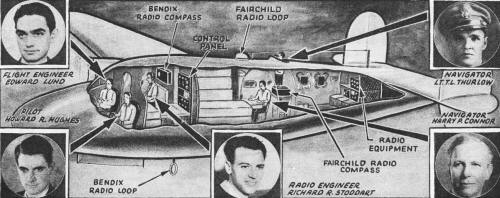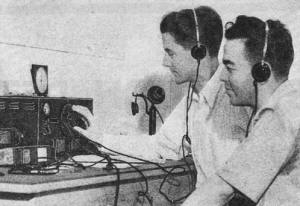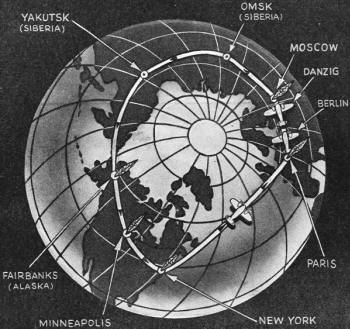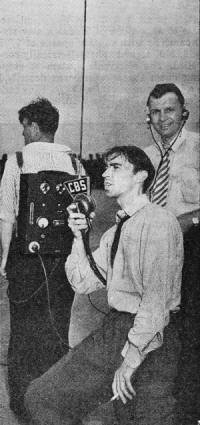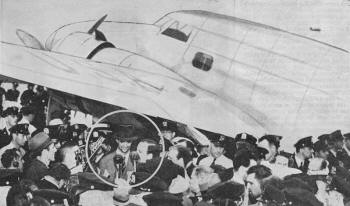Radio on a Globe-Circling Dash
|
||||||
A century from now somebody will re-publish a story about the first human voyage to the planet Mars, and many of the folks reading it - or at least its headline - will deem such information obsolete and not worthy of his/her/its time reading. The same is true for many of these historical articles I post here on RF Cafe for the benefit of those people who appreciate the efforts and sacrifices of men and women who came before us to push back the frontiers of ignorance. Howard Hughes, whose name is familiar to fewer and fewer people these days, was a well-known and, increasingly throughout his life, eccentric millionaire. He made his money in, among other ventures, the aerospace industry. Hughes Aircraft is one of his eponymous companies. Not only was Mr. Hughes an accomplished aerospace engineer and aircraft designer, but he was an excellent pilot as well. This story from a 1938 edition of Radio-Craft magazine reports on his bid to be the first round-the-globe flight to be in constant contact with terra firma operators via radio communications. Nowadays anyone with a cellphone can accomplish the same feat, just like someday anyone with enough money will be able to visit Mars. Aside: Hughes' famous Spruce Goose amphibious airplane did not fly until 1947. Radio on a Globe-Circling Dash
A "flying laboratory," hurtling around the world at 200 miles-per-hour, counts an extensive radio installation a necessity, and means of world-wide contact. Last month, bloodless wars were fought on 2 major fronts. First was the battle successfully waged, by Howard Hughes and his crew of 4 experts, against Time, and Nature; second, and less heralded, was the perhaps tie contest between the several networks for 1st Place in the radio sun. New York World's Fair, 1939, silver Lockheed 14 monoplane of aviator Hughes (a millionaire many times over), zipped around the Northern portion of the Northern Hemisphere, as mapped on the facing page, at the record-breaking pace of 205 miles-per-hour. The ship completed the approximately 15,000-mile flight in 91 hours, 8 minutes, 10 seconds - figures which include the slightly zig-zag course over Germany, at a comparatively slow speed (185 m.p.h.) and "over 10,000 ft." altitude, prescribed by Nazi officials. (Magellan took 1,083 days to circumnavigate the globe in 1519-'22.) Flight expenses were said by official sources to total over $300,000; the plane, with its elaborate radio installation as illustrated below, cost $200,000. Starting quietly enough, the flight ended in a blaze of glory - tumultuous greeting by 30,000 persons at Floyd Bennett Airport, from whence they had started only a few days previously - and a triumphal parade by motorcade up Broadway the next day, for more enthusiastic reception by 500,000 New Yorkers, who "baptized" the fliers with tickertape and other forms of paper, tons of it! Included in the 500 lbs. of radio equipment carried on the flight was a 15-watt, 10-inch-square, portable emergency radio outfit. This waterproof radio set was powered for 4 hours of continuous operation, and was supplied with a balloon, to be filled from an available nitrogen tank, for carrying an antenna into the air in the event of an emergency landing on land or water. A "casualty" of the flight was the loss, twice, of trailing antennas, which, in the second instance, temporarily put Hughes' plane out of radio contact with the listening world.
Important benefits of the flight included a 40-page report of flight minutiae, and information that Siberian mountains mapped as no higher than 6,500 feet, actually are more than 9,500 ft. - which is something that aviators flying blind would like to know; a night flight out of Yakutsk (Siberia) might have ended the flight in a crack-up, Hughes intimated. This information may spur research on the ultra-high frequency "absolute altimeter" now under development by the U. S. Bureau of Air Commerce in collaboration with the Bureau of Standards; and mentioned by Richard C. Gazely in a recent issue of the Air Commerce Bulletin. The device operates on the principle of reflection from a body (water, mountains, etc.); the "echo" time then determines the distance of the reflecting body. In one of 4 rooms of the Business Systems Building on the New York World's Fair site, a corps of radio engineers maintained almost unbroken contact with the Hughes plane. In one of these rooms an enormous wall map was used to keep track of the plane's progress; as radio position reports came in, a toy plane was moved forward to a new position on the line-of-flight. In another of the rooms, meteorologists and weathermen kept close tabs on incoming weather reports, and from them prepared forecasts for the avigators. In addition to the official reports given to networks announcers by Hughes' radio staff, listeners-in heard reports by the various press services, and listened to scheduled pick-ups from radio stations en route, as well as actual contact with New York World's Fair 1939. Following are reports supplied to Radio-Craft by the several networks that participated in bringing this epochal event into so many homes, here and abroad. N.B.C. From the moment Howard Hughes and his crew of 4 lifted their silver ship from Floyd Bennett Field to smash the existing round-the-world flight record radio was almost as busy setting records of its own. N.B.C., in fact, began long before the plane left the ground, then as the swift eastward flight astounded the world followed every move of the intrepid aviators for the benefit of its nation of listeners. Broadcasts began at the New York field, continued from mid-Atlantic, and multiplied when the Hughes crew set their plane down in Paris. The novel 2-way conversation carried on between N.B.C. officials at Radio City and the Hughes plane somewhere east of Newfoundland was broadcast, via the RCA Communications at Rocky Point and Riverhead, L. I. N.B.C. scored a clean scoop at Le Bourget in Paris when Fred Bate, N.B.C.'s European representative was on the air as the ship landed and continued through the frenzied welcome after the crew stepped from the plane.
The N.B.C. crew, communicating with the United States over A.T.&T. facilities at Netcong, N. J., also reported the take-off from the French capital. As the networks remained open to bring news of the flight's procedure over Germany, N .B.C. again picked up the fliers, including Hughes himself, as they passed Berlin. This was effected through the facilities of the Reichs Rundfunk and RCA Communications, the program originating in the plane and passed out over one of the 3 radio transmitters installed before Hughes left on his historic venture. At 4:20 A.M., EDST, Tuesday Hughes again came to the microphone, this time at the Moscow airport where he reported over the Russian government radio facilities, in touch with N.B.C. through RCAC. Then, as Hughes and his crew roared over Siberian wastes and touched at 2 points they were beyond reach of shortwave radio. N.B.C. was forced to rely on relayed reports reaching American listeners through an extension to Flight Headquarters, at the New York World's Fair ground, Flushing, L. I. It was not until the now-weary crew set foot on ground at Fairbanks, Alaska, that the world next heard the voices of the record smashers. The arrival and take-off was reported Wednesday night (July 13) over the shortwave facilities of the U. S. Army from Fairbanks to Seattle, where the program was fed into the N.B.C. networks. Again Hughes and his companions were silent for several hours as they proceeded toward St. Paul. But from that point on reports came thick and fast from all the towns on the course. And as the plane again set wheels on Floyd Bennett Field, N.B.C. had its pack sets, microphones and mobile unit placed strategically about the airport to give a complete, running account of the end of the fastest round-the-world journey in history. WNYC Although on the Hughes hop-off and landing WNYC only took "feeds" from N.B.C., the Municipal Station went in for a coverage of the Hughes reception that was as extensive as any station's. WNYC utilized its mobile shortwave transmitter WASJ, housed in a truck and followed the Hughes party from Battery Park to City Hall. Since the parade moved slowly, a WNYC announcer with a mike and several hundred feet of extension cord, was able to hop out during the parade and interview not only Stoddart, Thurlow and Connor, but their wives as well. The WNYC man was the first radio man during the parade to reach the cars of Thurlow, Stoddart, Connor and Lund, and scooped N.B.C. men with their portable pack transmitters. WNYC's announcer also got the first parade interview with young Tommy Thurlow, son of navigator Thomas Thurlow. After the ceremonies at City Hall, which WNYC covered in full, the parade was again followed by the shortwave truck as far as 5th Avenue and 9th Street. WOR-M.B.S.
Howard Hughes, his crew of 4 and the great silver-winged monoplane, New York World's Fair 1939, are back in New York. From Saturday (July 9) WOR and the Mutual network, under the direction of Special Features head G. W. Johnstone, remained on the air 24 hours a day, covering the plane's round-the-world flight almost mile by mile, bringing listeners broadcast after broadcast, either direct from the plane itself, or from one of the foreign airports at which the plane landed, or from the flight headquarters at the New York World's Fair in Flushing, New York. Included in this coverage - the most complete ever given such an event - were history-making exclusive broadcasts, each of which brought to America the first word of their latest position. These included exclusive broadcasts from the plane's cabin on Sunday (July 10) as it crossed the Atlantic Ocean, on Tuesday (July 12) as it reached Moscow, on Wednesday (July 13) as it landed at the airport at Fairbanks, Alaska, and on Thursday (July 14) when the plane first touched United States territory at Minneapolis on its final lap homeward bound. The whole series of broadcasts, numbering over 10 a day for 5 days, finally was brought to a conclusion with the breathless description of the end of the trip at Floyd Bennett Field on Thursday at 2:37 P.M. Immediately following that, announcers, engineers and fliers all went to bed. The Hughes flight which proved radio's boast of almost world-wide coverage did not present as many technical problems as the layman might imagine. WOR and the Mutual network described the take-off from New York's Floyd Bennett Field from the land and from the air. The broadcast was kept on the ground until the plane taxied to the end of the runway for its long dash down the field. Control was then switched to Dave Driscoll flying in an Eastern Air Line transport plane overhead. WOR engineers, under the direction of Charles Singer, had installed in the plane the network's regular relay broadcast transmitter, designed by station engineers. An intermediate frequency of 2,790 kilocycles was used for this broadcast. The signal was picked up at the Press Wireless station at Baldwin, L. I., and relayed to the network. At 2:30 A.M., July 11, Howard Hughes made a dramatic 8-minute broadcast from the New York World's Fair 1939, then more than 1,500 miles out of New York. This broadcast originated with the 100-watt composite transmitter aboard the Hughes plane, the signal again being received at Press Wireless with fine quality. The next contacts with the ship were made early the next day, Tuesday, as it winged its way from Paris to Moscow. Two broadcasts, one from a point over Germany, the other from above Poland, featured 2-way conversations with an English-speaking announcer of the Reich Rundfunk Gesellschaft in Germany. The signal was relayed to Press Wireless over the regular trans-Atlantic channels of the German transmitters. The landing in Moscow was described by an English-speaking Russian announcer stationed at the field. The Russians failed to make any tests prior to the actual broadcast so the signal was picked up cold at Baldwin, but with good understandable quality. This broadcast originated with one of the 500,000-watt shortwave Russian transmitters.
No further phone transmissions either from airport or plane were heard until the ship landed at Fairbanks, Alaska, Wednesday evening. While the Hughes Lockheed was flying from Moscow to Omsk and from Omsk to Yakutsk, Siberia, the flight was covered through bulletins received at flight headquarters in New York. The bulletins were transmitted in C.W. from the ship to Russian ground stations which in turn relayed to Moscow. Moscow forwarded the messages to New York. Because no wire lines could be made available from the Fairbanks field to the U. S. Army Signal Corps transmitter located some distance away Mutual contacted Pan American Airways and after talking with its Fairbanks manager, Joe Crosson, famous pilot of the North, arranged to have the air line operators and Crosson describe the landing and take-off through their own transmitter. The broadcast was picked up by the Signal Corps and relayed through their regular circuits to Seattle where sta-tion KOL of the Don Lee leg of Mutual made arrangements to feed the coast-to-coast network. Mutual scooped the country on the Minneapolis landing by maintaining flash service with A.T.&T. through Wednesday night and early Thursday so that network lines could be reversed to the Twin Cities if Hughes decided to land there. Arrangements were also made to pick up a shortwave broadcast from a Winnipeg transmitter which was to relay its description from the airport to its 2,000-watt transmitter by means of a mobile unit. This signal would have been picked up by Press Wireless with whom tests had been made. Hughes landed in Minneapolis, A.T.&T. reversed lines instantly and interviews with the crew and a description of the take-off were heard exclusively over Mutual. For the landing at Floyd Bennett Field 2 positions were used, one in the tower of the Administration Building, the other on the concrete apron to which Hughes taxied. At the latter point a pack transmitter was used in addition to land lines.
Posted October 11, 2020 |
||||||

